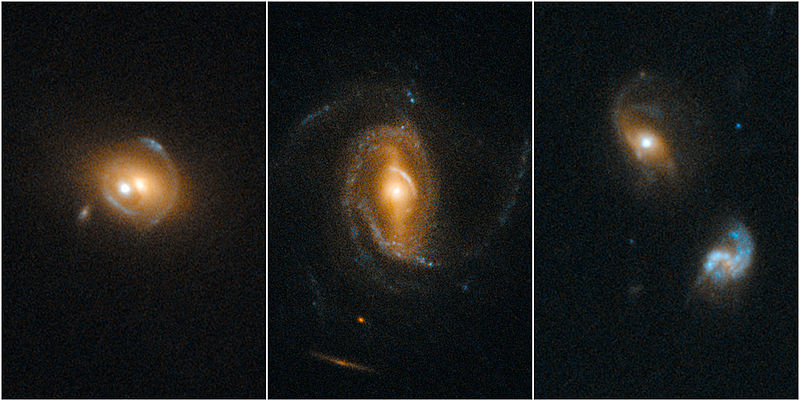Quasars

|
License: CC - 3.0
Quasars acting as gravitational lenses. To find these cases of galaxy–quasar combinations acting as lenses, astronomers selected 23,000 quasar spectra from the SDSS.
|
Quasars or quasi-stellar radio sources are the most energetic and distant members of a class of objects called active galactic nuclei (AGN). Quasars are extremely luminous and were first identified as being high redshift sources of electromagnetic energy, including radio waves and visible light, that appeared to be similar to stars, rather than extended sources similar to galaxies. Their spectra contain very broad emission lines, unlike any known from stars, hence the name "quasi-stellar." Their luminosity can be 100 times greater than that of the Milky Way. Most quasars were formed approximately 12 billion years ago, and they are normally caused by collisions of galaxies, with the galaxies' central black holes merging to form either a supermassive black hole or a binary black hole system.
The first quasars (3C 48 and 3C 273) were discovered in the late 1950s, as radio sources in all-sky radio surveys. They were first noted as radio sources with no corresponding visible object. Using small telescopes and the Lovell Telescope as an interferometer, they were shown to have a very small angular size. Hundreds of these objects were recorded by 1960 and published in the Third Cambridge Catalogue as astronomers scanned the skies for their optical counterparts. In 1963, a definite identification of the radio source 3C 48 with an optical object was published by Allan Sandage and Thomas A. Matthews. Astronomers had detected what appeared to be a faint blue star at the location of the radio source and obtained its spectrum. Containing many unknown broad emission lines, the anomalous spectrum defied interpretation — a claim by John Bolton of a large redshift was not generally accepted.
The Twin Quasar (Twin QSO or Double Quasar or Old Faithful, also known as SBS 0957+561, TXS 0957+561, Q0957+561 or QSO 0957+561 A/B), was discovered in 1979 and was the first identified gravitationally lensed object. It is a quasar that appears as two images, a result from gravitational lensing caused by the galaxy YGKOW G1 that is located in the line of sight between Earth and the quasar.
A gravitational lens refers to a distribution of matter (such as a cluster of galaxies) between a distant source and an observer, that is capable of bending the light from the source, as it travels towards the observer. This effect is known as gravitational lensing and the amount of bending is one of the predictions of Albert Einstein's general theory of relativity. (Classical physics also predicts bending of light, but only half that of general relativity's.
Although either Orest Khvolson (1924) or Frantisek Link (1936) is sometimes credited as being the first one to discuss the effect in print, the effect is more commonly associated with Einstein, who published a more famous article on the subject in 1936.
Fritz Zwicky posited in 1937 that the effect could allow galaxy clusters to act as gravitational lenses. It was not until 1979 that this effect was confirmed by observation of the so-called "Twin QSO" SBS 0957+561.
The Sloan Digital Sky Survey or SDSS is a major multi-filter imaging and spectroscopic redshift survey using a dedicated 2.5-m wide-angle optical telescope at Apache Point Observatory in New Mexico, United States. The project was named after the Alfred P. Sloan Foundation, which contributed significant funding.
Data collection began in 2000, and the final imaging data release covers over 35% of the sky, with photometric observations of around 500 million objects and spectra for more than 3 million objects. The main galaxy sample has a median redshift of z = 0.1; there are redshifts for luminous red galaxies as far as z = 0.7, and for quasars as far as z = 5; and the imaging survey has been involved in the detection of quasars beyond a redshift z = 6.
See also:
https://en.wikipedia.org/wiki/Quasar
https://en.wikipedia.org/wiki/Twin_Quasar
https://en.wikipedia.org/wiki/Sloan_Digital_Sky_Survey
Source: Wikipedia (All text is available under the terms of the GNU Free Documentation License and Creative Commons Attribution-ShareAlike License.)
|



